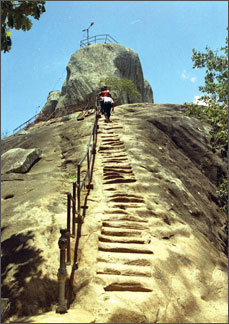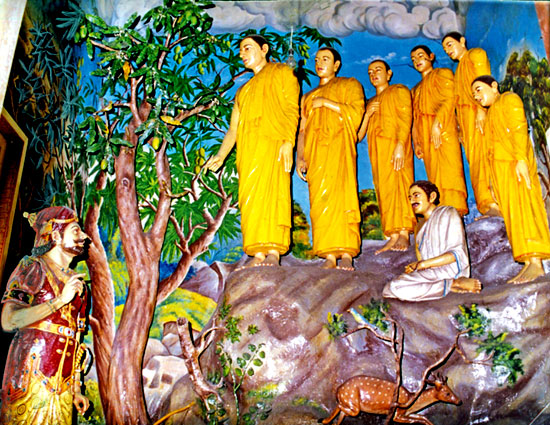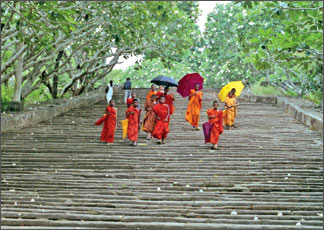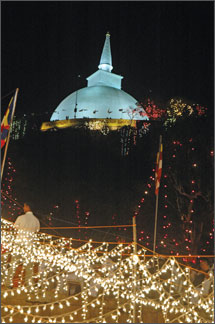Arahant Mahinda ushers in Buddhism
by Rupa BANDUWARDENA
  As the name suggests, Mahindagamanaya is of great significance to our
paradise isle which led it to be identified as Dharmadveepa. Sri Lanka
had the good fortune of being blessed with the supreme gift of the
Buddha, His doctrine and the message of the Dhamma. As the name suggests, Mahindagamanaya is of great significance to our
paradise isle which led it to be identified as Dharmadveepa. Sri Lanka
had the good fortune of being blessed with the supreme gift of the
Buddha, His doctrine and the message of the Dhamma.
Lanka's links with Jambudveepa are known to date back to the Buddhist
era. Later, when Emperor Asoka's mission to propagate the Dhamma at the
conclusion of the third Buddhist Council held at Pataliputra after the
Mahaparinibbana was launched, Lanka was the first place to attract his
attention.
Special importance had been attached to the island. The two kings of
the two countries had developed a very special friendship which led to
this celebrated religious event. The dedicated duo was responsible for
this immortal gift to Sinhaladeepa.
It was in the form of a precious gift from the Emperor to his loyal
friend that the Dhammadutha mission was sent here. Emperor Asoka's son
Arahant Mahinda Thera led the Buddhist mission to Sri Lanka.
He alighted on Missaka Pawwa on the Poson Full Moon Poya Day in
247BC. King Devanampiyatissa greatly impressed by the intellectual
conversation that followed, while engaged in a hunting spree, accepted
Buddhism, which action was followed by the people.
Thousands embraced the new faith. Mahinda Thera's first sermon was
Chullahattipadopama Sutta, the gem of truth embodied in the
philosophical teachings of the Buddha which was mainly responsible for
shaping the destiny and future of the country, creating a golden era
unparalleled in the annals of Sasanic history.
Pre-Mahinda era
The earliest available documentary sources Deepavamsa and Mahavamsa
give an elaborate account of the sacred visits of the Buddha to Sri
Lanka long before the introduction of His doctrine. The Buddha’s visits
are considered as a landmark gift to Buddhist heritage which tells us
about the unforgettable events, during the time of the living Buddha,
which in a way is even more important than the Thera's visit.
The soil of Lanka has been sanctified and blessed by the Buddha on
several occasions, very clearly supported by historical as well as
archaeological evidence.
More modern scholars such as Ven. Walpola Rahula Thera and Dr. E. W.
Adikaram who had done intense research on the subject are of the view
that Buddhism was known in Ceylon before the advent of Mahinda Thera.
According to them Sri Lanka was the only country to preserve the
Theravada doctrine - the original form of Buddhism coming direct from
the Buddha's time.
To be very brief, the Buddha visited Sri Lanka thrice. The most
sanctified places which he visited are Mahiyangana, Nagadeepa, Kelaniya
and Sri Pada. You can well and truly say that each visit of the truly
wonderful master occupies a unique place in the history of the island as
one that brought about peace and harmony among the inhabitants.
  But with the passage of time, the sanctity and serenity bestowed by
the Buddha during His visits had disappeared until it was renewed by
Mahindagamanaya. His arrival here 236 years after the Parinibbana was
too long a time for anything to continue, and therefore, it is perfectly
correct in concluding that this wonderful faith had to be started afresh
in Sinhaladeepa. But with the passage of time, the sanctity and serenity bestowed by
the Buddha during His visits had disappeared until it was renewed by
Mahindagamanaya. His arrival here 236 years after the Parinibbana was
too long a time for anything to continue, and therefore, it is perfectly
correct in concluding that this wonderful faith had to be started afresh
in Sinhaladeepa.
Then what was the country like before the advent of Thera Mahinda?
According to chronicles, the people were steeped in animism, primitive
beliefs and superstitious practices. During the Buddha's visits to which
reference was made earlier there had been Yakkha and Naga tribes
(subdued by the Buddha) who would have had practices such as worshipping
tree gods, rock gods, demons and devils and even the dead. Some had even
worshipped objects of nature - the sun, moon and rain.
History records that King Pandukabhaya built a temple for Yakka
Chittaraja and had a banyan tree set apart as the abode of Vais Ravana
and a palmyrah tree for Vyadackva both supposed to be tree deities.
He is also said to have built dwellings for Jains (Nigantas) and
Brahmins. These are good examples for the religious state of
pre-Buddhist Lanka. To these people the message of the Buddha gave a
definite way of life. One could call this the greatest civilising force
in the history of the island.
With the introduction of Buddhism, the three great symbols of the
Triple Gem - the Chetiya enshrining Buddhas relics, Vihara Ge with the
Buddha image and the Bo tree symbolising the enlightenment - became the
associated places of worship, giving inspiration and cultivating
devotion, creating a serene religious atmosphere as well as the
observance of discipline.
Compassion, Metta or loving kindness, boundless and limitless,
extended to all as Buddhism emphasises, gave them happiness and peace of
mind as never experienced before. The lofty moral code made them apply
Dhamma in their everyday life.
For the Buddha Sasana to flourish, Arahant Mahinda advised the King
to ordain the youth of the country to propagate the Dhamma and they
formed the nucleus of the Sangha.
A nephew of the King was the first to be ordained as Maharitta Thera.
Soon the numbers increased. Novices were trained for the Sangha.
Monasteries became centres of learning. The discourses on morality
delivered to the devotees were of great spiritual value to them.
The honour of preserving the Thripitaka where Buddhist philosophy is
enshrined, which remained unwritten but continued to survive in the
memory of the Mahasangha, goes to Mahinda Thera. Lankans are greatly
indebted to Him for this. He also brought here the literature of
Buddhism - the Pali canon, Jataka stories and the Kathavathu, orally
preserved by the Sangha which later become the source of the island's
history.
The great chronicles came into being with written history. The art of
writing too was introduced by Arahant Mahinda. The Brahmi Alphabet, the
script found in Asokan inscriptions, paved the way for the development
of modern Sinhala. Pali words and phrases crept into Sinhala and Pali
grammar influenced the structure of the language.
Cultural developments
Besides the spiritual message, Buddhism brought the island into
contact with the cultural developments in India. Brick and stone
architecture prevalent in India came to be used here for the viharas and
dagabas erected here. With massive dagabas, the ancient cities of
Anuradhapura and Polonnaruwa became impressive centres of cultural
values. Anuradhapura was known as the citadel of Buddhist civilisation.
Art flourished with great splendour. With the rise of schools of art
in India, sculpture and painting also became popular. Hence the
Mahindagamanaya and Mihintale played an important role in nurturing and
spreading Buddhism islandwide. The introduction of Buddhism by Arahant
Mahinda is therefore an event of great historical importance. |

